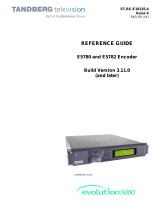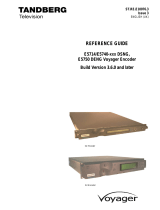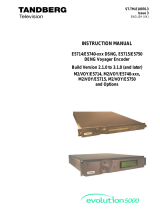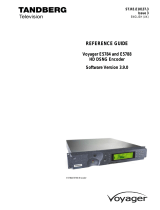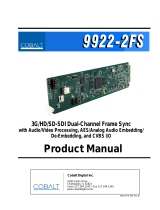Page is loading ...

Crystal Vision Ltd., Lion Technology Park, Station Road East, Whittlesford, Cambridge, CB22 4WL, England.
E-mail: [email protected] Website: www.crystalvision.tv Tel: +44(0) 1223 497049 Fax: +44(0) 1223 497059
SYNNER144
SDI synchroniser, tracking audio delay
and embedder/de-embedder

SYNNER144 User Manual R2.5 Crystal Vision
SYNNER144 User Manual R2.5 1 10/09/2007
Contents
1 Introduction 4
Synchroniser and Delay Modes 5
Video tracking 6
TAD versus slew rate 6
Predictive tracking 6
Adjusting the audio delay 7
Selecting the embed pattern 7
Freezing the picture 7
SDI loss behaviour 8
Synchroniser lock mode 8
Handling non-linear audio 8
Using the analogue video monitor output 8
Using the headphone monitor output 8
Optional input and output sub PCBs 9
1.1 Fitting audio sub-modules 9
1.2 Sub-module link settings 10
2 Hardware installation 18
2.1 Rear modules and signal I/O 18
RM04 18
RM05 20
RM07 22
RM26 23
RM30 24
2.2 Module Configuration 25
Loop or terminate the external reference 25
General Purpose Interface (GPI) 25

SYNNER144 User Manual R2.5 Crystal Vision
SYNNER144 User Manual R2.5 2 10/09/2007
3 Card edge operation 28
3.1 Card edge switch settings 28
3.2 Card edge rotary controls 28
3.3 Reading card edge LEDs 29
3.4 Navigating card edge menus 29
Card edge configuration 29
3.5 Card edge status operation 30
3.6 Using presets 34
3.7 Video and audio configuration 34
Selecting the video delay or offset 34
Selecting the Freeze Mode 35
Selecting the operating Mode 36
3.8 Audio selection and routing 40
Selecting embed/de-embed audio groups 40
Audio Routing 41
Choosing delayed audio groups to output from a sub PCB 44
Alarm configuration 45
Engineering settings 47
4 Using the active front panel 48
4.1 Module selected 48
4.2 The Synner144 menu structure 50
4.3 Video Configuration Menu 52
4.4 Audio Configuration Menu 53
4.5 Misc Configuration Menu 54
4.6 Stats Menu 56
5 Statesman 57
5.1 Statesman operation 57
Video properties 58
Audio selection and routing 60
Tracking delay and O/P sub PCB router 62
Alarms, presets and headphone monitoring 63

SYNNER144 User Manual R2.5 Crystal Vision
SYNNER144 User Manual R2.5 3 10/09/2007
Recalling factory defaults 65
6 Trouble Shooting 66
6.1 Card edge monitoring 66
Status LEDs 66
Fault finding guide 66
7 Specification 68
Revision 4 Menu correction page 38 05-06-07
Revision 5 Synchroniser locking mode clarification 12-07-07

Crystal Vision Introduction
SYNNER144 User Manual R2.5 4 10/09/2007
1 Introduction
SYNNER144 is a video frame/line synchroniser with tracking audio delay built-in for up
to two groups of embedded audio.
Two independent de-embedders can each accept four audio channels from a selected
incoming audio group, which is then re-sampled, delayed, re-routed and re-embedded into
any selected output audio group.
In addition, with the use of sub PCBs the SYNNER144 is able to accept up to four digital
or analogue channels and embed them as part of the selected two output groups. Likewise
four audio channels of either digital or analogue can be output, de-embedded from the
selected audio groups of the SDI input stream.
There are up to four SDI outputs, a SDI loop-through, and up to two composite video
outputs from an internal monitoring encoder.
The serial digital output has virtually no output jitter, both when used as a synchroniser
with a stable analogue reference, and when used as a delay line without a reference.
In Synchronisation Mode, the SDI output contains video that has been synchronised by
the frame synchroniser function, plus a total of up to eight embedded signals, which have
been de-embedded, re-sampled to 48 kHz and locked to the output SDI signal's video
content.
This provides delayed audio that tracks the video delay, with selectable additional audio
delay, as a fully synchronous embedded signal to SMPTE 272M.
When using 625-line video, picture disturbances on untimed input cuts are avoided by
waiting until line 23 to re-lock. Interruptions to the embedded audio, or unusual methods
of packing are automatically corrected.
The unit has a short minimum delay and a choice of black, blue or freeze on input failure.
SYNNER144 is particularly suitable for placing after a routing switcher where the
sources are several lines apart, or in installations using devices such as the Sony IMX
VTRs which record up to two groups of embedded audio.
The main features are as follows:
• Frame or line synchroniser or use as a fixed delay line
• Transparent audio follow video tracking built in
• Full vertical and horizontal adjustment from 0 to 2 fields in any mode
• Audio delay adjustment from 3ms to 20ms
• Fast lock after up-stream switch
• Corrects and/or masks audio corruption
• 24 bit input and output stages and dither enhanced 20 bit processing ensure high
quality operation
• Selectable black, blue or freeze on input failure
• EDH generation
• Option to pass or block non-linear data (Dolby E)
• Audio follow control output
• Analogue/AES audio in or out with an optional sub PCB fitted
• Composite monitor output
• Flexible control

Crystal Vision Introduction
SYNNER144 User Manual R2.5 5 10/09/2007
SYNNER144 is a 100mm x 266mm module, which fits in Crystal Vision’s four standard
frame sizes and can be integrated with any boards from the company’s full product range.
24 modules fit in 4U, 12 modules fit in 2U, six in 1U or two in a desk top box. It uses the
RM04, RM05, RM07, RM26 and RM30 rear connectors.
The embedded audio is handled as two sets of four audio channels (two stereo signals)
from each of two audio groups. Each selected audio group is handled by an independent
processing path.
SYNNER144 video and embedded audio synchroniser
Notes: Audio can be routed between any input and output groups by SYNNER144, the only
limitation being that all channels are treated in groups of two i.e. as stereo pairs.
Only re-embedded audio will be present in the SDI output stream, since the entire HANC
space is always blanked prior to the embedding process, except in the case of Dolby E
mode.
Synchroniser and Delay Modes
SYNNER144 has two modes of operation, Synchronisation and Delay.
In Synchronisation Mode the unit takes its timing from the analogue external reference
and will automatically synchronise sources with or without embedded audio between zero
and two fields. Synchronisation Mode is ideal for external sources that are not timed to
station references such as satellite or remote contribution feeds.
In Delay Mode, timing is derived only from the SDI input. Typical applications are where
a source passes through a processor such as a DVE, chroma keyer or standards converter
where the delay can be a few microseconds, multiple lines or up to two fields.
In either mode the video delay remains fully adjustable over two complete fields. This
allows the output of the SYNNER144 to be timed into any edit suite irrespective of the
timing of the black and burst reference used in Synchronisation Mode.
Also in either mode the audio delay can be configured to track the video delay and
provide an additional or offset delay to the video delay or to be configured for a fixed
delay. There is also an external audio follow video pulse output, the duration of which
reflects the current video delay. The AFV output can be used with external audio delay
processors if required.
Delay
Embed
group D
User
Configured
Routing
Control
Statesman
Remote Control
Board Edge
Control GPI I/O
A
udiofollow pulse
Composite
Encoder
De-embed
group A
De-embed
group B
Embed
group C
2 x Composite
monitoring O/Ps
4 x SDI with
Embedded Audio
A
ctive SDI
Loop-through
SDI with
Embedded Audio
A
IP2/DIP2
or DIP-RS
A
nalogue Audio
or AES Inputs
A
OP2 or
DOP2
A
nalogue Audio
or AES output
T
racking
A
udio Delay
re-sampling
and
Routing
V
ideo
Synchronise
r
Optional Sub-PCB Optional Sub-PCB

Crystal Vision Introduction
SYNNER144 User Manual R2.5 6 10/09/2007
Video tracking
When enabled, the built-in video tracking (strictly speaking Audio Follow Video
tracking) helps to ensure that the audio delay matches the video delay to maintain lip
sync. Although video tracking (AFV) can be used in both Synchronisation and Delay
Modes, it operates dynamically in Synchronisation Mode as input/output timing changes.
When video tracking is on in Synchronisation Mode, the rate at which the audio delay
tracks fast or abrupt changes in video delay is controlled by the tracking audio delay
(TAD) rate.
The faster the TAD speed, the faster the audio delay will match the video delay, but at the
expense of musical pitch.
Since the TAD speed can be audible as a pitch change the response time needs to be
chosen with care. A sports event may well benefit from a fast TAD speed but classical
music with piano and violins would require the slowest speed.
For example a TAD speed of 0.1% can cause a pitch change of the same value to be heard
as the audio delay catches up with the video.
To put this in perspective, imagine a piano recital is in progress and a concert pitch A
above middle C is heard. This has a fundamental frequency of 440Hz. A 0.1% change
would produce 440.44Hz. A sharp or B flat is 466.16Hz so in this case the audio delay
slew rate only causes a pitch change of the order of one sixtieth of a semitone.
The TAD speeds are 0.8%, 0.4%, 0.2%, 0.1% and 0.05%.
TAD versus slew rate
A 40ms change in video timing only takes five seconds at the 0.8% TAD speed. Each
decreasing response step takes double the time to catch up, so a 0.05% rate means that the
audio would take 80 seconds to catch up with the video.
The following table relates audio tracking response time to video changes for a range of
TAD values:
Video timing
change T.A.D.
0.05%
T.A.D.
0.1%
T.A.D.
0.2%
T.A.D.
0.4%
T.A.D.
0.8%
40ms 80
seconds
40
seconds
20
seconds
10
seconds
5 seconds
20ms 40
seconds
20
seconds
10
seconds
5 seconds 2.5
seconds
10ms 20
seconds
10
seconds 5 seconds
2.5
seconds
1.25
seconds
5ms 10
seconds
5 seconds 2.5
seconds
1.25
seconds
0.6
seconds
1ms 5 seconds 2.5
seconds
1.25
seconds
0.6
seconds
0.3
seconds
Predictive tracking
In Synchronisation Mode, there are two situations when the video delay changes abruptly
between zero and two fields: when the video delay increases to the point where it is about
to jump from one full frame delay to zero and when it decreases to the point where it is
about to reach zero and then jump to one full frame delay.
To avoid the need for large changes in audio delay or noticeable lip sync problems it may
be better to change the audio delay in anticipation of the imminent jump in video delay.

Crystal Vision Introduction
SYNNER144 User Manual R2.5 7 10/09/2007
If there is no predictive tracking (i.e. set to off) then only after the jump in video delay
does the audio delay start changing. As a result, there is a short period of time just after
the jump in video delay where the audio is offset from video by 40ms (625 line systems -
33ms for 525L).
When predictive tracking is on, then as the video delay jump approaches, the audio delay
starts to change so that significant audio delay change has already been effected prior to
the jump in video delay.
With predictive tracking on, the relative audio timing will always be within the
recommended window (less than 16ms ahead or 24ms behind).
When the video delay or rate of change is small, the audio delay will track and remain
very close to the value of video delay, until the point where predictive tracking function
(if ON) will compute that predictive offset is required.
To ensure that lip sync errors are minimised during the necessary jumps in video timing
with asynchronous inputs in Synchronisation Mode, make sure that the predictive
tracking is on and that an appropriate TAD value for the programme material has been
selected.
Predictive tracking is not available in Delay Mode.
Adjusting the audio delay
The audio delay can be controlled independently of the video delay from 0 to 20ms.
If video tracking is off the actual audio delay is set manually. If video tracking is on the
audio delay is automatically controlled to match the video delay. However the offset
timing between audio and video remains adjustable in any mode.
Audio delay Description
Video tracking on Audio delay controlled automatically to follow
video delay
Relative timing available
Video tracking off Actual audio delay controlled manually
Note: Audio delay dynamically follows video delay in Synchronisation Mode and when video
delay is manually changed when video tracking is on in either Synchronisation or Delay
Mode.
Selecting the embed pattern
The SYNNER144 supports two different embedding formats, Sony or SMPTE. The Sony
format embeds on every line of the SDI output, whereas the SMPTE format omits
embedding from one line before the vertical interval switch point as defined in SMPTE
RP168, through to three lines after - a total of a four line gap in each and every TV field.
The input format does not require setup as it is automatically detected.
The format chosen should match the most common format in use, or set to SMPTE if in
any doubt.
Freezing the picture
The type of picture freeze used when the freeze command is given may be selected from
frame, field 1 and field 2. If there is movement between both fields a frame freeze may
show movement judder. A field freeze works by repeating the same field to produce a

Crystal Vision Introduction
SYNNER144 User Manual R2.5 8 10/09/2007
synthetic frame of video, without movement judder. However a field freeze is more likely
to show jagged edges on near horizontal lines.
The audio output is always muted when the video is frozen. The embedded packet
structure is maintained but the packets contain silence.
SDI loss behaviour
The SYNNER144 behaviour when the SDI input is lost may be selected to cut to black,
cut to blue, freeze, or hold a freeze for approximately one second before outputting a blue
or black screen. The picture freeze type selected will determine the freeze displayed.
Synchroniser lock mode
With 525 line sources the re-lock is timed from the field flag to accommodate different
lengths of vertical blanking. Normally when operating with 625 line sources
SYNNER144 re-locks on the input at the start of active video. This means that if a switch
occurs between untimed sources there will be no disturbance in the active video if both
the sources are in vertical blanking when the switch occurs. To allow operation with 625
line sources that have non-compliant vertical blanking lengths, it is possible to select a re-
lock timed from the field flag.
Handling non-linear audio
Embedded data that is not linear audio, such as Dolby E, can be blocked or passed
transparently through the video store with the SDI video.
Using the analogue video monitor output
Data in the VBI (vertical blanking interval) of the analogue composite monitor output can
be blanked or passed. 7.5% IRE setup may be applied to active video when a 525
standard SDI signal is used (composite monitor output will be NTSC).
Using the headphone monitor output
The card edge jack socket (3.5mm, stereo) can be used to monitor the four stereo audio
signals which have been selected for de-embedding from the four input audio groups by
the A & B Channel de-embedders. Also to monitor the four possible stereo audio signals
that can be re-embedded on two of the output audio groups by the C & D Channel
embedders.
It can also be used to monitor the two stereo channels present when an optional sub PCB
is fitted.
These analogue audio signals are only available through the headphone jack socket.
Note: There are no outputs to the rear connectors, as there are with TANDEMs, TAD202 and
Demon.
Tip: The headphone output will not drive non-amplified speakers. Use with active
loudspeakers, or a pair of headphones.

Crystal Vision Introduction
SYNNER144 User Manual R2.5 9 10/09/2007
Optional input and output sub PCBs
With the addition of an optional audio sub PCB of the type fitted to the TANDEM range
of cards, it is possible to greatly increase the flexibility of the SYNNER144.
Provision is made to fit one audio sub PCB. This can be either an analogue or AES input
type or an output type.
By the fitting of an input sub PCB, the user is able to embed up to two stereo pairs of
input audio and insert them into the SDI output stream along with the second embedder
programme.
By substituting the input sub PCB for an output card it then becomes possible to extract
audio from the input SDI stream that may have been mistimed to the video, once it has
been through the synchroniser and the timing corrected.
Note: It will be necessary to also fit a HD-DCDC18 PSU sub PCB when any of the analogue
sub PCBs are used.
1.1 Fitting audio sub-modules
As of late 2006 the full range of I/O sub PCBs were supplemented with the new HD
range of I/O sub PCBs. Both ranges of sub PCB are fully compatible and either can be
use on the SYNNER144.
SYNNER144 card showing analogue audio sub-modules and PSU sub-module fitted
To fit a sub-module proceed as follows:
• ensure that all static electricity precautions have been taken
• fit two module retaining screws (3x10mm) from below the main PCB, and add a
nylon spacer (3x3mm) on top of the SYNNER144 PCB to each screw for each
sub-module location – hold screws firmly in place
• offer up the chosen sub-module to its intended position on the SYNNER144
main card
• check that the orientation is correct and that retaining holes and header sockets
line up with the corresponding holes and header plugs on the main card
• push the sub-module in place firmly taking care not to bend any pins

Crystal Vision Introduction
SYNNER144 User Manual R2.5 10 10/09/2007
• fit the retaining fibre washers, internal serrated washers and nuts to the two
retaining screws
Removal is the reverse of the above procedure.
Notes: All items are supplied with the SYNNER144 module.
All sub-modules must be fitted with the component side uppermost and flat (track side)
down, facing the SYNNER144 PCB. Fitting sub-modules with the component face
downwards may result in fatal damage.
To check which modules are fitted when a SYNNER144 is already in place in its frame,
use the option status check (menu 5) at the card edge or the active control panel status
menu or the Statesman status screen.
1.2 Sub-module link settings
AOP2
The analogue audio output module provides two stereo pairs or four mono outputs that
may be used as destinations when routing de-embedded signals. Link jumpers are
provided to allow 0dBFS to be set to +18dBu or +24dBu. The variable adjustments on the
card are set at the factory and should not require re-adjustment. Set channel 1 with
JL1/RV1, channel 2 with JL2/RV2, channel 3 with JL3/RV3 and channel 4 with
JL4/RV4.
J1
JL 1 ~ 4
^24 dBu
¬18 dBu
J2
J3
CRYSTAL VISION LTD
Aop
JL2
JL1
RV1
RV2
RV3
RV4
JL4
JL3
AOP2
Selectable jumper links are provided to change input and reference terminations and pre-
set levels, depending on sub-module features.

Crystal Vision Introduction
SYNNER144 User Manual R2.5 11 10/09/2007
AIP2
The AIP2 is identified on the silkscreen as the AIP2-LP to indicate its lower power
consumption. The analogue audio input module provides two stereo pairs or four mono
signals that may be used as a source in subsequent embedding. Link jumpers are provided
to allow 0dBFS to be set to +18dBu (rearwards, towards J1) or +24dBu (forwards,
towards J2/3). The variable adjustments on the card are set at the factory and should not
require re-adjustment. Set channel 1 with JL4/RV4, channel 2 with JL2/RV2, channel 3
with JL1/RV1 and channel 4 with JL3/RV3. Take care to note the adjustment and
channel numbering on this sub-board.
J1
JL 1 ~ 4
< 24 dBu
> 18 dBu
J2
J3
CRYSTAL VISION LTD
Aip LP
JL4 RV4
RV2
RV1
RV3
JL2
JL1
JL3
AIP2
DOP2-110
This digital audio output module provides two 110 Ohm AES stereo pairs or four mono
outputs that may be used as destinations when routing de-embedded signals.
J1
^AES
¬Word Clk ^AES2
¬REF I/P
^110R
¬75R
> OPEN=HI Z
J2
J3 CRYSTAL VISION LTD
110R DOP
JL1
JL4 JL3 JL2
DOP2-110

Crystal Vision Introduction
SYNNER144 User Manual R2.5 12 10/09/2007
DOP2-75
This digital audio output module provides two 75 Ohm AES stereo pairs or four mono
outputs that may be used as destinations when routing de-embedded signals.
J1
^AES
¬Word Clk ^AES2
¬REF I/P
^110R
¬75R
> OPEN=HI Z
J2
J3
CRYSTAL VISION LTD
75R DOP
JL3
JL4 JL2 JL1
DOP2-75
DIP2
This digital audio input module provides two AES stereo pairs or four mono channels that
may be used as sources in subsequent embedding.
J1
JL 1/2
^110R
¬75R
> OPEN=HI Z
J2
J3
CRYSTAL VISION LTD
Dip
JL2
JL1
DIP2
Link jumpers are provided to select between 110 Ohm (upper 2 pins), HiZ (balanced –
centre pins only) or 75 Ohm (unbalanced – lower 2 pins).

Crystal Vision Introduction
SYNNER144 User Manual R2.5 13 10/09/2007
DIP2RS
This digital audio input module provides two AES stereo pairs or four mono channels
with an integral re-sampler for use when the AES input is either asynchronous, or at a
sample rate other than 48 kHz.
DIP2-RS
The sample rate inputs can work with signals from less than 30 kHz to 108 kHz. It is
particularly useful for asynchronous 48 kHz inputs, and other sample rate inputs such as
44.1 kHz and 96 kHz.
The signal output from the DIP2-RS to the SYNNER144 is at 48 kHz derived from the
video content of the SDI signal into which it is to be embedded.
Because of the processing of the audio wave form, error words indicated by V-bit set high
are ignored. Occasional errors marked by V-bit high such as would be the case with a
noisy or too long AES input path, are masked out by the processing.
If the V-bit is consistently high, to indicate continuous error states, or to indicate non
audio data, then the processor will give a silent output. All other cards pass audio data
unaltered even when V-bit is set or held high.
Link jumpers are provided to select between 110 Ohm (upper 2 pins), HiZ (balanced –
centre pins only) or 75 Ohm (unbalanced – lower 2 pins). Jumper JL3 must be in the
Tandem position.
Notes: Balanced outputs require the use of rear modules with a D-Type connector and
unbalanced outputs are for use with BNCs.
HiZ is achieved by removing termination jumpers – they can be parked for safe keeping
by replacing them using only one pin.

Crystal Vision Introduction
SYNNER144 User Manual R2.5 14 10/09/2007
HD-AOP2
The analogue audio output module provides two stereo pairs or four mono outputs that may be
used as destinations when routing de-embedded signals. Link jumpers are provided to allow
0dBFS to be set to +18dBu or +24dBu. The variable adjustments on the card are set at the
factory and should not require re-adjustment. Set channel 1 with PL1/P1, channel 2 with
PL2/P2, channel 3 with PL3/P3 and channel 4 with PL4/P4.
HD-AOP2
Selectable jumper links are provided to change input and reference terminations and pre-set
levels, depending on sub-module features.
HD-AIP2
The analogue audio input module provides two stereo pairs or four mono signals that may be
used as a source in subsequent embedding. Link jumpers are provided to allow 0dBFS to be
set to +18dBu (rearwards, towards J1) or +24dBu (forwards, towards J2/3). The variable
adjustments on the card are set at the factory and should not require re-adjustment. Set
channel 1 with PL2/RV2, channel 2 with PL1/RV1, channel 3 with PL4/RV4 and channel 4
with PL3/RV3. Take care to note the adjustment and channel numbering on this sub-board.
HD-AIP2

Crystal Vision Introduction
SYNNER144 User Manual R2.5 15 10/09/2007
HD-DOP2-110
This digital audio output module provides two 110 Ohm AES stereo pairs or four mono
outputs that may be used as destinations when routing de-embedded signals.
HD-DOP2-110
HD-DOP2-75
This digital audio output module provides two 75 Ohm AES stereo pairs or four mono outputs
that may be used as destinations when routing de-embedded signals.
HD-DOP2-75

Crystal Vision Introduction
SYNNER144 User Manual R2.5 16 10/09/2007
HD-DIP2
This digital audio input module provides two AES stereo pairs or four mono channels that
may be used as sources in subsequent embedding.
HD-DIP2
Link jumpers are provided to select between 110 Ohm (upper 2 pins), HiZ (balanced – centre
pins only) or 75 Ohm (unbalanced – lower 2 pins). J3 must be selected for 20-bit.
HD-DIP2-RS
This digital audio input module provides two AES stereo pairs or four mono channels with an
integral re-sampler for use when the AES input is either asynchronous, or at a sample rate
other than 48 kHz.
HD-DIP2RS
The sample rate inputs can work with signals from less than 30 kHz to 108 kHz. It is
particularly useful for asynchronous 48 kHz inputs, and other sample rate inputs such as 44.1
kHz and 96 kHz.
The signal output from the HD-DIP2-RS to the SYNNER144 is at 48 kHz derived from the
video content of the SDI signal into which it is to be embedded.
Because of the processing of the audio waveform, error words indicated by V-bit set high are
ignored. Occasional errors marked by V-bit high such as would be the case with a noisy or too
long AES input path, are masked out by the processing.

Crystal Vision Introduction
SYNNER144 User Manual R2.5 17 10/09/2007
If the V-bit is consistently high, to indicate continuous error states, or to indicate non-audio
data, then the processor will give a silent output. All other cards pass audio data unaltered
even when V-bit is set or held high.
Link jumpers are provided to select between 110 Ohm (upper two pins), HiZ (balanced –
centre pins only) or 75 Ohm (unbalanced – lower two pins).
Notes: In general, balanced outputs require the use of rear modules with a D-Type connector
and unbalanced outputs are for use with BNCs.
HiZ is achieved by removing termination jumpers – they can be parked for safe keeping
by replacing them using only one pin.

Crystal Vision Card edge operation
SYNNER144 User Manual R2.5 18 10/09/2007
2 Hardware installation
The SYNNER144 single height module uses the RM04, RM05, RM07, RM26 and RM30
rear connectors and fits into all Crystal Vision rack frames. All modules can be plugged
in and removed while the frame is powered without damage.
Note: The RM05 can only be used in the Indigo 2 and Indigo 4 frames.
2.1 Rear modules and signal I/O
The Indigo 4 4U frames will house up to 24 single height modules with up to three power
supplies. The Indigo 2 2U frames will house up to 12 single height modules and dual
power supplies. The Indigo 1 1U frames will house six single height modules and a single
or dual power supply. The Indigo DT desk top box has a built-in power supply and will
house up to two single height modules.
Note: For details of fitting rear connectors please refer to the appropriate frame manual.
RM04
RM04 modular rear connector Description
SDI OUT SDI OUT AUDIO/REF IN/OUT SYNC IN SDI IN
ZLA00231 RM04 SYNNER
RM04 (ZLA00231 artwork)
• 24 SYNNER modules per
Indigo 4 frame
• 12 per Indigo 2 frame
• Six per Indigo 1 frame
• Two per Indigo DT desk top
box
• All frame slots can be used
Note: One SYNNER144 card can be fitted to each RM04 rear module.
BNC Function
SDI IN Serial digital input
SYNC IN Composite sync (B & B) input
SDI OUT Serial digital output
SDI OUT Serial digital output
The RM04 high density 26 way D-Type female socket has the following pin assignments
for each fitted audio option card:

Crystal Vision Card edge operation
SYNNER144 User Manual R2.5 19 10/09/2007
AIP2/AOP2
HD-AIP2/HD-AOP2 DIP2/DIP2-RS
HD-DIP2/HD-DIP2-RS DOP2-110
HD-DOP2-110 DOP2-75
HD-DOP2-75 pin-out
GND GND GND GND 1
No connect No connect No connect No connect 2
No connect No connect No connect No connect 3
No connect No connect No connect No connect 5
No connect No connect No connect No connect 7
No connect No connect No connect No connect 8
No connect No connect No connect No connect 18
GND GND GND GND 9
Analogue audio 1L+ AES1+ AES1a+ AES1a 14
Analogue audio 1L- AES1- AES1a- GND 15
Analogue audio 1R+ AES1scrn AES1b+ AES1b 10
Analogue audio 1R- NC AES1b- GND 11
Analogue audio 2L+ AES2+ AES2a+ AES2a+ 16
Analogue audio 2L- AES2- AES2a- AES2a- 17
Analogue audio 2R+ AES2scrn AES2b+ AES2b 12
Analogue audio 2R- NC AES2b- GND 13
Common Monitoring Connections
Composite video OPA 4
Composite video OPB 6
GND 19
GND 20
No connect 21
No connect 22
GND 23
GND 24
No connect 25
No connect 26
The monitoring connections are the same for all fitted option cards.
The RM04 rear module allows cards to be placed in all frame slots.
/

